| Srl | Item |
| 1 |
ID:
147647
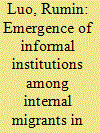

|
|
|
|
|
| Summary/Abstract |
China’s dramatic economic development and urbanisation have led to an increase in its number of internal migrants. As of 2013, this group accounted for more than 20 per cent of the country’s population, and approximately 70 per cent of people in this group are working in the informal economy. This paper pays special attention to migrant-traders in the informal sector and the strategies they use in Shanghai. Migrants are doubly marginalised by the hukou (户口) and danwei (单位) systems in the megacity and have only limited access to social welfare. It is argued that the informal strategies of these marginalised actors develop in related patterns of social relationships and institutional constraints. Such strategies create new forms of informal institutions that are justified and gain legitimacy when countering unequal and hierarchical formal institutions and social arrangements. This paper empirically explores how informal institutions can act in parallel with or diverge from formal institutions, and how they might influence formal institutions in the long term.
|
|
|
|
|
|
|
|
|
|
|
|
|
|
|
|
| 2 |
ID:
147648
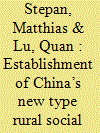

|
|
|
|
|
| Summary/Abstract |
This study explores the processes and outcomes of the public policy reforms from 2002 to 2014, targeting income security among the elderly for a segment of the Chinese population that was increasingly marginalised throughout the 1990s: the rural population. The authors reconstruct the policy process from 2002 until 2014 that led to the establishment of the New Type Rural Social Insurance Pension and assess its impact on providing adequate and sustainable old-age income. One particular focus is the study of the influence of international actors. Yet, as key to the success of the initiative, the authors identify the decisive support of the central level leadership, which facilitated the process by announcing a new development model and providing earmarked transfers from the central government. Despite the improvements in the income security of elderly rural Chinese, questions remain about the Chinese pension system’s long-term sustainability and the influence of the system’s fragmentation on social mobility and equality.
|
|
|
|
|
|
|
|
|
|
|
|
|
|
|
|
| 3 |
ID:
147650
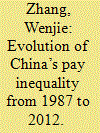

|
|
|
|
|
| Summary/Abstract |
This paper provides new estimates of the evolution of pay inequality in China, overall and also by region and sector, in the period from 1987 to 2012, using the between-group component of Theil’s T-statistic measured across regions and sectors. We find that China’s overall pay inequality started to rise rapidly in the early 1990s and that it peaked in 2008, with the between-province component peaking as early as 2002. Since 2008, overall pay inequality has decreased, with between-province and between-sector inequality both showing steady declines. We argue that China’s pay inequality during the reform period was not simply a matter of economic inequality; it was the joint product of both market and institutional forces. In this vein, we also argue that the recent decline of overall pay inequality after the 2008 global economic crisis was not a temporary phenomenon triggered by the global downturn, but a long-term outcome driven by both economic and policy factors.
|
|
|
|
|
|
|
|
|
|
|
|
|
|
|
|
| 4 |
ID:
147646


|
|
|
|
|
| Summary/Abstract |
Most migrant workers in mainland China are officially covered by the New Rural Cooperative Medical System (NRCMS), a rural health insurance system that operates in their home communities. The NRCMS and the system of household registration (户口, hukou) are tightly linked and systemically interdependent institutions. Migrant workers have difficulties benefitting from this social protection because it remains spatially separated from them. Only a minority have access to urban health insurance systems. This paper sheds light on the institutional origins of the coverage problem of migrant workers and examines crucial policy initiatives that attempt to solve it. In the context of the ongoing hukou reforms, these policies aim to partially dissolve the systemic interdependence of hukou and health insurance. While the policies provide feasible, yet conflict-prone, solutions in short-distance and concentrated bilateral migration systems, covering migrants who cross provincial boundaries remains a challenge.
|
|
|
|
|
|
|
|
|
|
|
|
|
|
|
|
| 5 |
ID:
147649
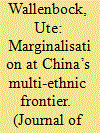

|
|
|
|
|
| Summary/Abstract |
China consists of a mosaic of many territorial ethnic groups whose historic homelands have been incorporated into the modern Chinese state, a process by which the respective populations transformed from a “sovereign or semi-sovereign people” (Bulag 2002: 9) on China’s periphery into “minority nationalities” (少数民族, shaoshu minzu). In 1950 Mao Zedong initiated the “Ethnic Classification Project” whose effect has been the marginalisation of the minority nationalities. In this paper, I explore the marginalisation of the Mongol population of contemporary Henan Mongolian Autonomous County within the Huangnan Tibetan Autonomous Prefecture in southeastern Qinghai Province. By seeking to understand how Henan Mongols deal with their socio-political and demographic marginal status, the aim of this article is to shed light on how they utilise their marginal position, and how they centralise themselves as an independent party interacting with the civilising missions of China and Tibet.
|
|
|
|
|
|
|
|
|
|
|
|
|
|
|
|
| 6 |
ID:
147644
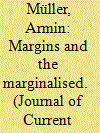

|
|
|
| 7 |
ID:
147645
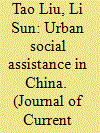

|
|
|
|
|
| Summary/Abstract |
In 1999 the State Council of the People’s Republic of China (PRC) introduced the Regulation on the Minimum Living Standard Scheme(MLSS, 低保 or dibao) for urban residents in China. Policy learning from different parts of the world significantly shaped the formation and expansion of the MLSS, and Chinese social policy researchers have drawn conclusions about the experiences of these multiple regions. Through expert interviews, we discovered that the Chinese social assistance scheme has been influenced by the US ideas of “social investment” and “workfare.” Furthermore, the European values of “universal entitlement” and “social citizenship” have also been internalised by the Chinese actors behind the scheme. In addition, Hong Kong’s social assistance scheme has inspired Chinese policymakers to explore a model consisting of various categories that target the country’s enormous special welfare needs. Thus, scholars and policymakers from China have used values and ideas outside China to create a hybrid model of social assistance that is characterised by broad coverage, a low benefit level, and a highly provincial administrative structure.
|
|
|
|
|
|
|
|
|
|
|
|
|
|
|
|